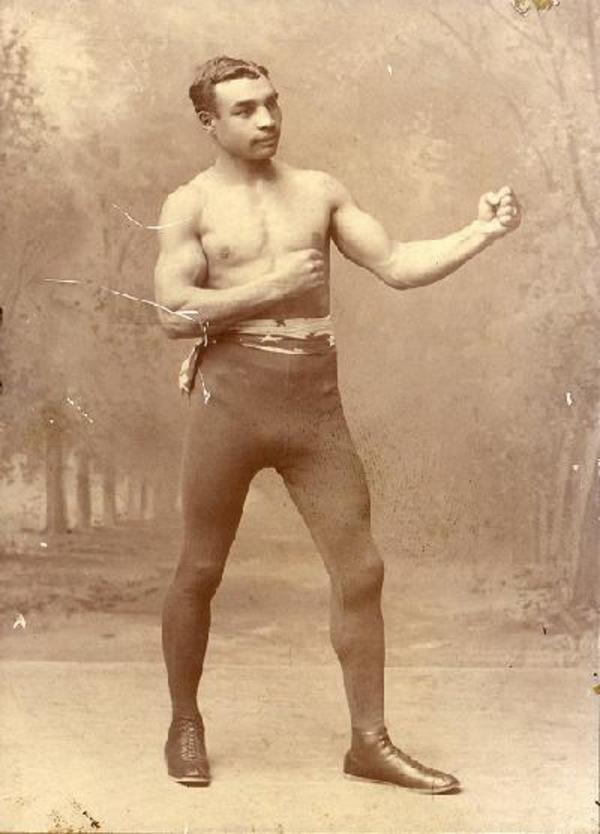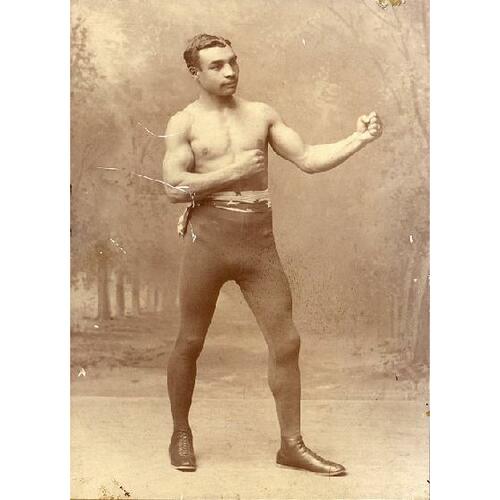
Source: Link
BYERS, GEORGE FREDERICK, boxer and boxing instructor; b. 25 June 1872 in Charlottetown, son of William Byers and Charlotte Ellen Goodwin; m. Julia Churchill, who predeceased him; d. 10 April 1937 in Boston.
George Byers, like his prize-fighting cousin George Godfrey* before him, grew up in the Bog, a poor mixed-race neighbourhood in Charlottetown’s West End. He was a third-generation descendant of John Byers, known as Black Jack, and his wife, Amelia, a slave couple brought to St John’s (Prince Edward) Island by Lieutenant-Colonel Joseph Robinson*, formerly of the South Carolina Royalists regiment, after the American Revolutionary War. The extended Byers family was the largest in the Bog community, which grew in the early 19th century as slavery was informally ended on the Island through the gradual manumission of the slaves who had arrived in the 1780s with loyalists and British officials. Two of John and Amelia’s sons, Sancho and Peter* Byers, both of whom had become free men, were hanged in 1815 for separate minor property crimes, showing that slavery’s curse had outlasted its practice on the Island.
While most members of his family were stuck with hard labouring jobs such as chimney sweeper, longshoreman, and construction worker, George Byers was among those who left the Island to seek opportunities in the United States. He received some boxing lessons from Dick Cronin before leaving Charlottetown in 1890 for Boston, where he probably had support from Godfrey, a prominent bare-knuckle fighter who ran a boxing school in the city and was the son of George’s aunt Sarah Byers Godfrey. Most, possibly all, of Byers’s bouts would be fought with gloved hands for prize money, often in gambling halls that were subject to raids by the police. Rounds were three minutes long, each followed by a one-minute break, and competitive matches were most often scheduled to last between 6 and 25 rounds. Those that went the distance were normally decided on points awarded by judges or by the decision of the referee, although draws were sometimes prearranged between the boxers’ camps so that they could split the money if both men were still standing at the end of the fight.
Byers’s first professional contest was a 3-round draw against Jack Colbert on 23 Aug. 1895 in Boston. Over the next nine years he would box across the United States as a welterweight, middleweight, light heavyweight, and heavyweight, despite the fact that he was only 5 foot 8½ inches tall and had a maximum fighting weight of 165 pounds. One report from a Boston newspaper in 1900 noted that he was boxing as a welterweight but challenging a champion middleweight: “It has been the ambition of Byers to get a match with Tommy Ryan [World Middleweight Champion, 1898–1907], but the latter draws the color line when pressed for a chance by Byers.”
Although titles for black fighters in this era were apparently neither well regulated nor well documented, records indicate that during his career Byers captured the coloured middleweight and coloured heavyweight championships of the world. He took the middleweight crown from Harry Peppers by stopping him in the 19th round on 9 Dec. 1897 in Waterbury, Conn. It is not clear whether he defended this title, however, and it had apparently become vacant by 1907, when the great Samuel Langford*, a Nova Scotian protégé of Byers, won it in a challenge match. Byers took the heavyweight championship by defeating Frank Childs on points in a 20-round bout in New York City on 14 Sept. 1898, and he held the title until Childs gained it back with a 17th-round knockout on 16 March 1901 in Hot Springs, Ark. When he retired in 1904, Byers had 20 wins, 7 losses, and 20 draws in 47 recorded fights (he likely participated in many more), with 14 wins and 4 losses that came by knockout.
For many years Byers continued to box in exhibition matches that usually lasted 3 rounds, including a 1909 contest in Boston against Jack Johnson, who had recently defeated Noah Brusso* (Tommy Burns) to become the first black heavyweight champion of the world. Byers also ran a gym and boxing school in Boston. His most famous pupil was Sam Langford, who recalled in his autobiography that “before I could get the tricks working that George taught me, I didn’t do so good in knocking boys dizzy. But after a while things got going better and I could hook with the lefts like George showed me. Then I began shortening the evening’s entertainment for the customers.” Byers sometimes travelled with Langford to serve as his second, and a photograph taken in 1910 shows them together in Los Angeles, where Langford was preparing for a match and where the two men held an exhibition bout.
Though he has had “Budge” attached to his name, Byers does not appear to have fought under this moniker, and it is difficult to find reported usage of it. During a 1920 visit to Charlottetown he was lauded by a local newspaper for finishing his boxing career in good health: “Notwithstanding the long period of thirty years and the fact that he has time and again been at grips with some of the hardest fighting men on the continent, time has dealt gently with George, and he is looking in the pink of perfection.” Byers died of pneumonia in Boston on 10 April 1937 at the age of 64.
George Byers left a very narrow set of options in Charlottetown’s small black community and, with few assets beyond physical skill and courage, fought his way across the United States, taught boxing in Boston, and toured Europe and America with Sam Langford. Perhaps his most singular achievement among boxers of his era was that he retired in good health, such that he could enjoy his success for many years.
Mass., State Dept. of Public Health, Registry of vital records and statistics (Boston), death certificate, no.3898. U.S. National Arch. and Records Administration (Washington), United States census, 1910, Mass., Middlesex, Cambridge, Ward 4; United States census, 1920, Mass., Suffolk, Boston, Ward 8; World War I draft registration cards, 1917–1918 (mfm. 1509), George Frederick Byers. Charlottetown Guardian, 17 June 1920, 12 April 1937. Evening Mail (Halifax), 16 Aug. 1924. Examiner (Charlottetown), 23 April 1900. Wilf McCluskey, “Ring ramblings,” Journal-Pioneer (Summerside, P.E.I.), 11 Oct. 1972, 26 March 1975. Patriot, 12 April 1937. BoxRec, “George Byers”: boxrec.com/boxer/40088 (consulted 14 Dec. 2016). Cyber Boxing Zone, “George Byers”: www.cyberboxingzone.com/boxing/GeorgeByers.htm (consulted 14 Dec. 2016). Jim Hornby, Black Islanders: Prince Edward Island’s historical black community (Charlottetown, 1991); In the shadow of the gallows: criminal law and capital punishment in Prince Edward Island, 1769–1941 (Charlottetown, 1998).
Cite This Article
Jim Hornby, “BYERS, GEORGE FREDERICK,” in Dictionary of Canadian Biography, vol. 16, University of Toronto/Université Laval, 2003–, accessed January 2, 2026, https://www.biographi.ca/en/bio/byers_george_frederick_16E.html.
The citation above shows the format for footnotes and endnotes according to the Chicago manual of style (16th edition). Information to be used in other citation formats:
| Permalink: | https://www.biographi.ca/en/bio/byers_george_frederick_16E.html |
| Author of Article: | Jim Hornby |
| Title of Article: | BYERS, GEORGE FREDERICK |
| Publication Name: | Dictionary of Canadian Biography, vol. 16 |
| Publisher: | University of Toronto/Université Laval |
| Year of publication: | 2020 |
| Year of revision: | 2020 |
| Access Date: | January 2, 2026 |



